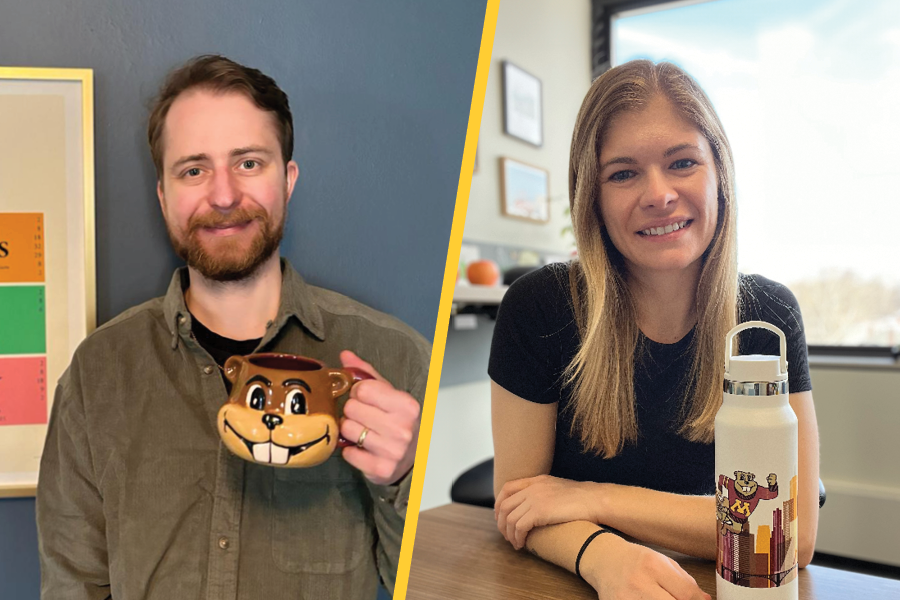Jan-Niklas Boyn and Kade Head-Marsden join Department of Chemistry

MINNEAPOLIS / ST. PAUL (3/13/2024) – Dr. Jan-Niklas Boyn and Dr. Kade Head-Marsden will join the Department of Chemistry faculty in Fall 2024. The department will welcome both chemists as Assistant Professors.
Jan-Niklas (Nik) Boyn will join the University of Minnesota from Princeton University, where he is currently a Postdoctoral Research Associate with Prof. Emily Carter in the Department of Mechanical and Aerospace Engineering. His research utilizes multi-level embedding simulations to elucidate atomic- level processes pertaining to carbon capture. Before his position at Princeton, Boyn received a MChem from the University of Oxford, where he carried out research in computational organic chemistry under Prof. Robert Paton, and a Ph.D. in theoretical chemistry from the University of Chicago in Prof. David Mazziotti’s group, developing reduced density matrix based electronic structure methods.
Boyn’s research interests lie in the area of computational and theoretical chemistry, where he aims to develop multi-level computational tools that allow researchers to bridge different length- and time-scales. As most chemical processes occur in solution, at interfaces, or in the solid-state, their accurate simulation requires us to not only resolve their electronic structure but also effects arising from structural fluctuations or their extended structure. However, scaling limitations of commonly utilized computational chemistry methods impose significant limitations on the size of systems and time-scales that may be simulated, meaning chemists often have to resort to incomplete model systems and static simulations, or utilize classical approximations, which do not capture quantum mechanical effects.
“In the Boyn group we will utilize a combination of several approaches to develop new multi-level algorithms to overcome such limitations. Utilizing so-called multi-level embedding approaches, which partition systems into smaller fragments that may be treated with different levels of theory, we will combine enhanced sampling and machine-learning accelerated molecular dynamics simulations with reduced-density-matrix based electronic structure algorithms,” Boyn says. “We are interested in resolving the fundamental electronic and magnetic interactions in strongly correlated molecular systems and extended materials that are targets in the development of qubits, spintronic devices, and metalloclusters and metalloenzymes. We also aim to elucidate the atomic-level processes involved in promising CO2 capture technologies, particularly via metal-organic-framework and ionic-liquid based absorption.”
Boyn is a passionate mentor of undergraduate students and hopes to involve undergraduates in his group in meaningful ways here at UMN. “I think that this is a promising pathway to increase diversity in STEM by getting undergraduate students excited about a career in research and science at an early stage. Particularly, in the area of computational chemistry, a lot of the projects are quite accessible for undergraduate students, allowing them to not only learn a lot about chemistry and physics, but also gain valuable coding and scientific computing skills,” Boyn says.
UMN’s interdisciplinary nature and collaborative energy between units within the College of Science and Engineering were big drivers for Boyn’s move to Minnesota. “A big draw of UMN is the exchange between scientists in different departments and the ability as a computational/theoretical chemist to contribute to experimental efforts, especially in areas relating to sustainability and renewable energy,” Boyn says.
Outside of the office and lab, Boyn likes to spend a lot of time in the outdoors. He enjoys sailing, boating, fishing and hiking. He is also a passionate cook and has recently been getting into curing and smoking his own meat and fish.
Kade Head-Marsden will join the Department of Chemistry from Washington University in St. Louis, where she has been an Assistant Professor for the past two years. She received her Ph.D. in theoretical chemistry under Prof. David Mazziotti from the University of Chicago in 2019, then was a postdoctoral fellow with Prof. Prineha Narang in the Paulson School of Engineering and Applied Sciences at Harvard University.
Head-Marsden’s research group works in theoretical quantum chemistry with a primary focus on open quantum systems, which are small quantum systems whose properties and dynamics are driven by the surrounding environment. The group is specifically interested in the dynamics of electrons under the influence of complex environments, often relevant in molecular, material, and biological systems. “This links quite nicely to quantum information science, since quantum bits, or qubits, themselves are open quantum systems,” Head-Marsden says. “Current quantum hardware could provide a natural platform to consider these types of dynamical processes. To this end, one area of my group’s research explores using current quantum computers to model and predict these lossy quantum dynamics.” Much of the group’s research is interdisciplinary in nature, and Head-Marsden says she and her group are looking forward to the potential for collaborations within both the Department of Chemistry and the broader CSE scientific community.
Getting undergraduate and early graduate students excited about quantum sciences is at the core of what excites Head-Marsden as a professor. She says that she is looking forward to continuing to support young scientists of all backgrounds in her research group and to incorporate hands-on modules and case studies into her classroom.
Head-Marsden says she is looking forward to being part of the vibrant and collaborative research community the University of Minnesota offers, including the Chemical Theory Center. “Outside of the office, I’m excited to explore the many lakes and trails Minnesota has to offer. I try to be outside as much as possible, or practicing hand balancing,” she says.